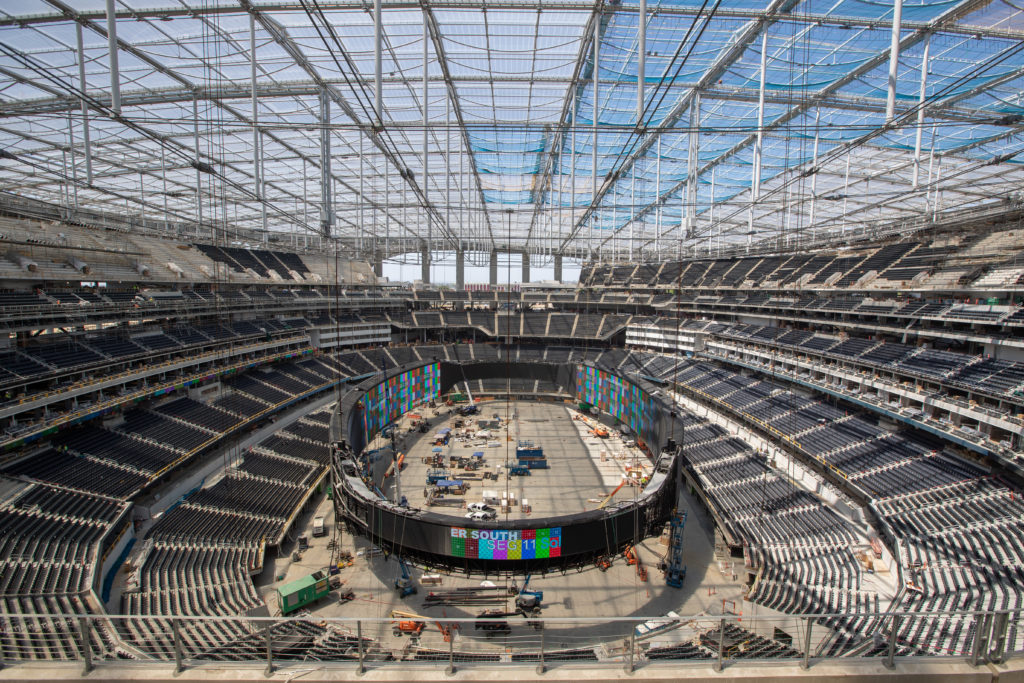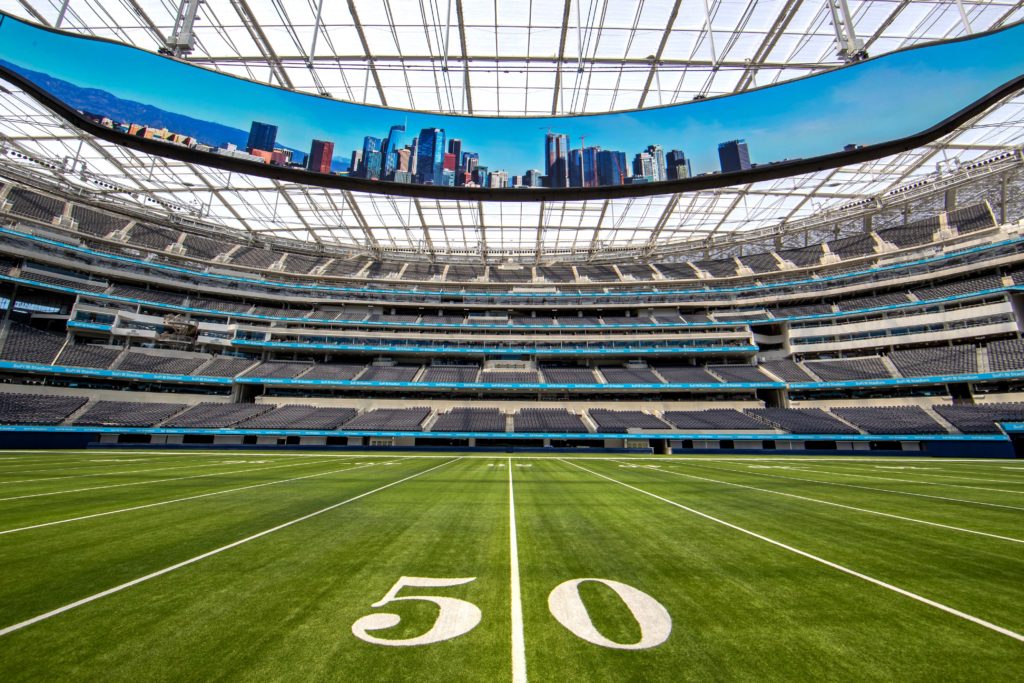L.A.’s SoFi Stadium, Home to Super Bowl LVI, was Built with American-Made Steel
Share

The “bowl” of the massive complex was constructed with nearly all American manufactured and fabricated steel.
SoFi Stadium, the site of Sunday’s Super Bowl, could have whimsically been called Sci-Fi Stadium.
Sci-Fi, or science fiction, is often said to inspire a “sense of wonder.” It explores alternatives to present-day society through futuristic and innovative concepts. SoFi Stadium, an unprecedented and awe-inspiring sports and entertainment destination located in the Los Angeles suburb of Inglewood, certainly fulfills those requirements.
It’s also Made in America.
“It was all American steel. The whole bowl of the stadium was all American steel,” said Dieter Klohn, president and CEO of SME Steel Corporation, which guided the construction of the football stadium. “That’s what we do. We are an American company and very proud of it.”
SoFi Stadium is billed as the first indoor-outdoor stadium, constructed with a sweeping, futuristic-looking canopy shell that many observers have said has a gigantic spaceship-like appearance. It looks like an object that could have come out of the sky and landed on a rare unoccupied piece of ground in Los Angeles County.
But on Sunday, the airborne objects flying around the SoFi Stadium football field will be limited to the passes thrown by quarterbacks Matthew Stafford and Joe Burrow as the Los Angeles Rams face off against the Cincinnati Bengals in Super Bowl LVI.
SoFi Stadium is named after Social Finance Inc., a financial technology company that is paying more than $30 million annually over 20 years to put its name on the home of the NFL’s Los Angeles Rams and Los Angeles Chargers. The privately funded, state-of-the-art stadium, which reportedly has a price tag of $5.5 billion, is owned by Kroenke Sports & Entertainment. Stan Kroenke is the billionaire owner of the Los Angeles Rams.
Located on a 298-acre parcel of land that was once home to the Hollywood Park horse racing track, SoFi Stadium is labeled an indoor-outdoor stadium because the canopy shell that covers the stadium is not attached to the bowl as is traditionally done with indoor stadiums. It is a free-standing roof that is anchored in four separate locations on the outside of the actual stadium structure.
Along with covering the football stadium itself, the sweeping, wave-like canopy also shelters a 6,000-seat concert amphitheater and a 2.5-acre plaza that borders a 6-acre lake complete with waterfalls. When complete, the Hollywood Park Entertainment compound will also include a 25-acre landscaped outdoor park for general public use.
The first Super Bowl to be played in Los Angeles in 29 years will take place in the actual SoFi Stadium building of the massive complex. At first glance, it may appear to have been constructed in a futuristic time and place, but the football venue is truly a modern-day, American innovation.
The bowl, or actual football stadium itself, was constructed with nearly all American manufactured and fabricated steel under the guidance of SME Industries, a West Jordan, Utah steel fabricator with 30 years of experience in the erection of sports stadiums and event venues.
Klohn is proud of SME Steel Corporation’s American-made contribution to such a massive project, which required sourcing of materials from all around the globe, including steel from Nucor-Yamato in Blytheville, Ark. and EVRAZ North America in Portland, Ore.
“We supplied 60,600 tons of structural steel and 12,500 tons for our other product CoreBrace, which are buckling restrained braces that provide seismic stability to the stadium in case of an earthquake,” Klohn said. “We were responsible for all of the structural steel, fabrication and erection.
“We were also responsible for all the miscellaneous metal in what was referred to as the brightwork – the stainless steel for the railings and things associated with the stairs, seating and luxury boxes.”

Almost the entire suite of SME Industries companies participated in the iconic project, including SME Steel Contractors, Southwest Steel, ornamental metals facility Southwest Architectural Metals, CoreBrace and heavy-haul trucking company SME Logistics. SME employs approximately 1,600 American workers and hired an additional 353 Ironworkers from Local 433 in Los Angeles to facilitate the steel erection of the stadium.
The structural steel from the Nucor mill in Arkansas was shipped by rail to SME’s 186,000 square-foot fabrication facility in Utah and its 180,000 square-foot plant in Pocatello, Idaho in early 2017, and made its way to the stadium construction site later that year. The topping-out ceremony, when the final steel beam is placed at a building site, was held on June 26, 2018.
But the stadium was far from complete. There were many finishing touches involving metal railings and stairwells that needed further work and the massive translucent canopy that covers the stadium had yet to be built under the direction of Arizona-based Schuff Steel fabricators.
“We went beyond the topping out, but the project went flawless for us, and we finished the project three days ahead of schedule,” Klohn said. “It was a huge project for us. We had, like, 5,000 feet of steel railings, and in just the architectural railings there were areas that were aluminum and glass that were over 70,000 square feet.
“It was really a massive project. Just the steel bolts, there were over 300,000 for example, and there was all this equipment. At one time, we had five cranes running around the clock. It was like a project on steroids.”
SoFi Stadium is a manufacturing, construction and architectural design marvel. The seating capacity is 70,240, which is expandable up to 100,240 for the upcoming Opening and Closing Ceremonies for the 2028 Olympic Games. It is the largest stadium in the NFL at 3.1 million square feet, and features 260 luxury suites and 13,000 premium seats.
The land at SoFi Stadium’s Hollywood Park site is 3 ½ times the size of Disneyland in nearby Anaheim. It will eventually house a retail district, office space, residences and a hotel. SME also is involved in the structural steel fabrication for the retail and office development.
During the stadium’s peak construction period, as many as 3,500 workers were on-site daily and more than 17,000 workers have contributed to the project, amassing more than 18 million worker hours.
When the groundbreaking ceremony for SoFi stadium took place in November 2016, it had been 21 years since the Rams left Southern California and moved to St. Louis. The original plans had the scheduled opening of the stadium for the 2019 season, but record rainfall in Southern California pushed back the opening until 2020.
The stadium’s completion was further delayed with the onset of the COVID-19 pandemic, which slowed construction because of California’s many health and work restrictions.
The first NFL game to be played at SoFi Stadium was played without fans in attendance on Sunday Sept. 13, 2020, when the Rams hosted the Dallas Cowboys. Both the Rams and the Chargers played the remainder of their 2020 schedule at SoFi Stadium, but fans were not allowed to attend because of Covid restrictions.
The first game at SoFi Stadium in which fans were allowed to watch in person was a 2021 preseason game between the two teams that call the stadium home – the Rams and the Chargers. The first NFL regular season game at the stadium with fans in attendance was on September 12, 2021, when the Rams defeated the Chicago Bears 34-14.
SoFi Stadium was designed by the renowned sports venue architectural firm HKS, which also designed stadiums for the Dallas Cowboys, Minnesota Vikings and Indianapolis Colts. There are nine levels of seating in the stadium and from different points of the top level, spectators can see the Pacific Ocean, the Hollywood Sign, and Los Angeles International Airport (LAX).
The stadium, located just three miles from LAX, is in the flight path of airline traffic, so when construction began a 100-foot hole below grade was excavated so that the huge construction cranes would not interfere with the radar system at LAX. The football playing surface, artificial turf known as Matrix Turf with Helix, sits 100 feet below street level.
The canopy that covers the stadium consists of 309 ETFE (Ethylene tetrafluoroethylene) panels, which are supported by a cable net that can open 46 of the panels to provide ventilation when climate conditions dictate the need. Since the stadium is not an enclosed indoor dome, the open sides also allow for comforting breezes to flow throughout.
The panels on the canopy are embedded with 27,000 LED pucks which project images from inside the stadium onto the outside cover of the stadium. Passengers aboard airplanes flying into LAX can get a glimpse of the game going on inside when flying over the stadium.
“It’s the largest LED screen ever put on a roof in the world,” said Skarpi Hedinsson, chief technology officer for SoFi Stadium. “For all intents and purposes, it’s a tv on top of the roof that is about 14 acres in size. It’s about 6 ½ city blocks and it’s a TV screen.”
And inside the stadium, the Infinity Screen videoboard is the largest ever created in sports weighing 2.2 million pounds and displaying 70,000 square feet of digital LED. The Infinity Screen sits 122 feet above the playing field and is both longer (120 yards) and wider than the actual playing field.
Super Bowl LVI (56) marks the eighth time the NFL title game will be played in metro Los Angeles. SoFi Stadium is truly a testament as to how far American innovation has come since the very first Super Bowl was played to a half-empty stadium at the Los Angeles Memorial Coliseum in 1967.
The Super Bowl will be broadcast on NBC television. Kickoff is scheduled for 6:30 p.m. Eastern.
